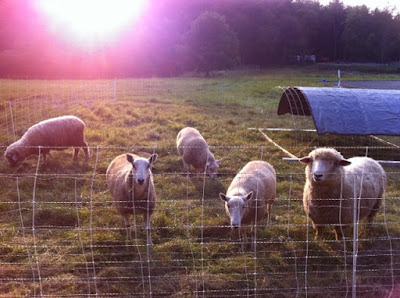When Dave and I got the message that a woman in Bedford was looking to sell five of her sheep my first thought was, absolutely not. After all, prudence tells me that we should grow slowly, and so do the majority of organic farming how-to books.
“But isn’t part of the fun getting in over our heads a little?” Dave asked.
True, there are organic farming how-to books that would agree. The Dirty Life,for example (a great read). Well, maybe, I thought. So we did some research, went and visited them, spent hours writing pro and con lists, and decided that it was too late, we had already fallen in love.
Can you blame us?
 |
| Laurel, the most friendly |
Plus, we justified, lamb will make our meat CSA that much more desirable next year (if you’re interested, subscribe to our mailing list on the right). And I’m pretty excited about their wool as well.
Luckily for us, sheep are pretty easy to take care of. They eat primarily grass, are very hardy, and are extremely sweet. We’re committed to raising them organically, without any vaccines or antibiotics, so that means that the only tricky part is we’re going to have to intensely rotationally graze them. That means they’ll have to be moved almost daily (and definitely daily next spring when we have lambs that are much more susceptible to parasites). Moving them everyday means that they will more fully graze the pasture. As one sheep owner explained, “if you give them too much space to graze, they’ll eat all the cake and none of the vegetables”. It also means that they won’t be grazing over a build up of their own excrement, therefore reducing the chances of them getting parasitic diseases.
Again, we turned to Wellscroft Fence Systems in New Hampshire, and they hooked us up with some lightweight electric sheep fencing and a lot of great advice. For now, we’re grazing them on the back pasture, with plans to install some permanent fencing and bring them up closer to the house this winter.
 |
| Grazing |
 |
| A Cheviot |
 |
| Phlox (Romney), on the left. Laurel (Romney) in the foreground. Bonnie, Blair and Bridget (the three Cheviots) next to Phlox. |
 |
| They love the moveable shelter Dave built them. |
We purchases five ewes, two Romneys and three Cheviots. We’ll breed them this fall and hopefully they’ll all twin in the spring, providing us with lamb for market by October. Both are considered good breeds for meat and fleece. The Romneys are known as good sheep for beginners, very easy going, while the Cheviots are considered a little more wild. Cheviots are said to have been roaming the hills between Scotland and England as early as the 14th Century (wikipedia) and are “noted for hardiness, longevity, productiveness, milking, and mothering ability and for their great activity” (American Cheviot Sheep Society). Because they are “hill sheep” and were often left to their own devises, they are more skittish and wary of predators than the more trusting Romneys. We figured it would be worthwhile to try out a couple different breeds.
So you can all look forward to more sheep stories this winter.
